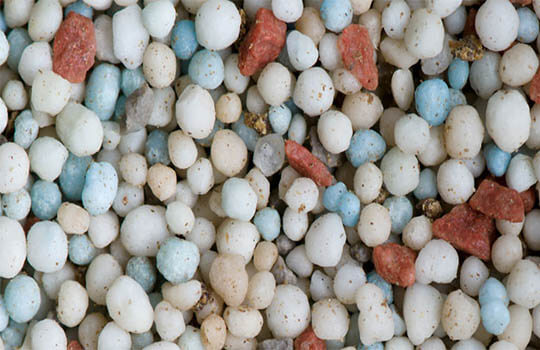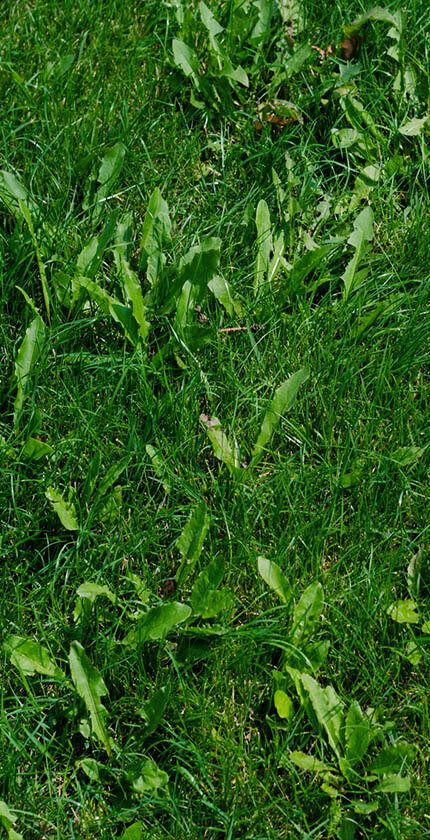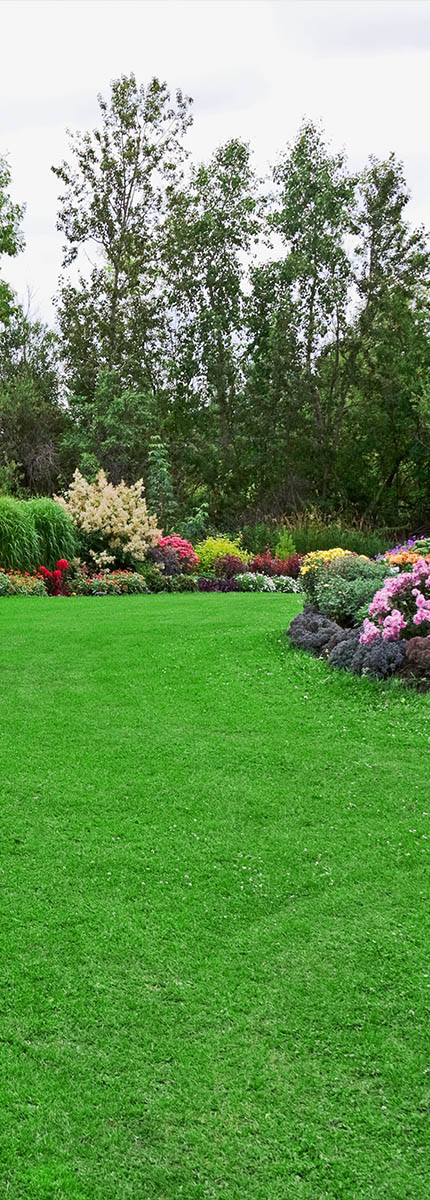
Lawn Care
The key to successful lawn care is knowing what your lawn needs and when your lawn needs it. The look of a beautiful front yard is something we all take pride in. We're here to help you get there in understanding the basics of fertilizer, controlling and preventing weeds and starting a new lawn. Click on the three main areas of lawn care below for the details.
- Fertilizer Basics:N, P and K – understand what they do for your lawn, why you need them regularly and when to apply them.
- Weed Control:Grasses and broadleaf weeds can be more harmful to your lawn than you think. Find out where to start in controlling the weeds in your lawn and if you need to use herbicide.
- Caring for a New Lawn:Trying to reseed or start a new lawn? There are numerous factors to consider when planting a new lawn and steps to take to assure your planting is successful.
Fertilizer Basics
The Analysis
You can’t expect to have a lush green lawn without knowing what fertilizers are, what’s available and what your lawn needs. Each bag of fertilizer has an analysis of the nutrients of the fertilizer, for example “24-0-10”. The first component you see on a bag of fertilizer stands for nitrogen (N). The “24” means there is 24% nitrogen in the bag. Nitrogen is the most important element you can add to your lawn to make the grass grow and get its green color. It also helps to create lawn thickness, shoot density and sturdy growth to help fight off weeds and pests. Normally, the second component you see in the series stands for phosphorus (P). The “0” means there is 0% phosphorus in the blend. Phosphorus is used primarily to encourage strong grass root growth and establishment. Starter fertilizers usually contain phosphorus to encourage fast growth of new lawns or to revive old lawns. The last component in the series stands for potassium (K). The “10” represents 10% potassium. Potassium is used to enhance your lawn’s resistance to disease, drought, wear and cold weather. The three ingredients can be blended into numerous combinations to create a fertilizer that is perfect for your lawn.
When to Fertilize
The key component to fertilizing your lawn is to fertilize year round. Ideally, lawns should be fertilized four times each year to effectively control weeds and nourish your lawn. In spring, you should fertilize with a crabgrass preventer, like Green Pro Crabgrass Preventer 27-0-8Our crabgrass preventer prevents crabgrass seeds from sprouting, controls young seedlings from taking over your lawn and fertilizes in one application. Crabgrass preventers should be applied from March thru early May.
The second feeding your lawn needs is a weed and feed product, like Green Pro Weed ‘N’ Feed 25-0-8. Weed and feed products should be applied from April thru June to fertilize and control broadleaf weeds in your lawn – weeds like dandelions, clover, chickweed or plantain. Essentially, you can apply a weed and feed product any time during the season as long as the weeds are up.
The third feeding can tend to be the one that is forgotten, but it’s the most crucial to protect your lawn from the stress of summer. Green Pro Lawn Fertilizer 24-0-10 is designed to help fight off summer stressors such as excessive heat, drought and high traffic. Lawn fertilizer should be applied from July thru September. It is also an ideal all-season fertilizer with slow release nitrogen for continuous feeding if you prefer to not use crabgrass preventer or weed and feed. You can use it anytime or multiple times throughout the summer.
The last feeding is a winterizer, which is normally applied from late August thru November and is designed to prepare your lawn for the harshness of winter. Green Pro Winterizer 26-0-13 has a root-building formula to withstand winter dormancy, encourage drought resistance and increase plant hardiness.
BCA Products has created a convenient 4 Step Revive and Thrive Program to guide you as to what product to apply and when it should be applied if you are uncertain.

The Breakdown: 24 - 0 - 10
Nitrogen – Phosphorus - Potassium
- The first component you see on a bag of fertilizer stands for nitrogen (N). The “24” means there is 24% nitrogen in the bag.
- The second component you see in the series stands for phosphorus (P). The “0” means there is 0% phosphorus in the blend.
- The last component in the series stands for potassium (K). The “10” represents 10% potassium.

Controlling Weeds in Your Lawn
The most effective method of controlling lawn weeds is to maintain a dense and vigorously growing turf cover. Increasing numbers of weeds are often an indication of problems in the grass plant’s environment that create less than favorable conditions for it to grow. Killing the weeds without correcting the underlying problem will lead to unsatisfactory results. Often, lawn weeds can be controlled simply by altering the cultural practices to favor the grass plants rather than the weeds. Cultural controls may include raising (or lowering) the mowing height, changing the frequency of mowing, lengthening (or shortening) the period between irrigations, increasing (or decreasing) the application of fertilizer or aerating the soil. A combination of proper cultural practices and prudent use of pre- and post-emergent herbicides is a good approach to effectively control lawn weeds.
Pre-emergent herbicides are most effective against annual weeds that come back from seed every year, such as crabgrass and quack grass. It’s important to remember that a pre-emergent herbicide does not kill the seed prior to germination. The seed must start to grow and sprout such that when the newly emerging root, shoot or both contact the herbicide, they are killed. To be effective, apply pre-emergent herbicides before you expect weed seeds to germinate. In a typical year, apply pre-emergent herbicides from late March to May or once soil temperatures in the top one inch or so are consistently in the 55° to 60°F range as measured early in the day. Pre-emergent herbicides must be watered into the soil to be effective. Depending on the soil type, ¼ to ½ inch of moisture should be applied following application of these products. We offer a pre- and post-emergent crabgrass preventer, Green Pro Crabgrass Preventer, that allows for up to 180 days of control preventing the crabgrass from sprouting, as well as controlling it at the 2-3 leaf stage.
Post-emergent herbicides are used to kill weeds when they are young and growing vigorously, or in the fall when perennial weeds are storing food in their roots for the next year. Green Pro Weed ‘N’ Feed with Viper is our post-emergent herbicide that controls more than 250 broadleaf weeds including dandelion, clover, ground ivy (creeping Charlie), knotweed and plantain. Post-emergent herbicides can be applied anytime during the season, but many people tend to apply it 6-8 weeks after a crabgrass preventer, typically sometime between April and June. They are usually most effective when absorbed through the leaves of the weed, so we recommend post-emergent herbicides be applied when there is a heavy dew or right after it rains. Consequently, you shouldn’t water your lawn for 48 hours after you apply herbicide because heavy rainfall will wash off the herbicide.
Starting A New Lawn
The best time to seed a lawn is late summer (mid-August to mid-September) due to favorable conditions for germination and growth. In addition, fewer weed seeds are germinating that might compete with the grass seedlings. Lastly, there is ample time for the plants to become well established before winter. Seeding can also be done in early spring. However, weeds and high summer temperatures often reduce the chance of success.
Select the Right Seed: In the upper Midwest, Kentucky bluegrass, fine fescue and some of the perennial ryegrass cultivars are recommended. However, before a seed mix is chosen, the site location and your expectations should also be evaluated. Factors to consider include the amount of shade present and how much wear and tear the lawn will receive. Another factor to consider is the level of maintenance you are willing to perform
Prepare the Soil: Till or drag the area you plan to seed. Be aware that when you till the soil, weed seed that was dormant can now germinate. Testing the soil to check the pH will help determine if any additional nutrients are required to balance the pH. Consider adding lime to help make the soil more water and air soluble. For sandier soils, consider adding a layer of topsoil to help maintain nutrients and water. The grass seed should smother most of the weeds if proper care is given.
Prepare the Seed Bed: Smooth out the soil with a hand rake or drag to make the soil as level as possible. Be sure to remove any stones, debris or existing weeds. Don't pack the soil too firmly before seeding.
Apply a Starter Fertilizer: BCA Premium Lawn Starter 18-22-6
Apply the Seed as Directed: Consider cutting the spreader setting in half and making two passes for better coverage. Rake the seed lightly into the soil and use a roller if available. For larger areas, you may want to consult a lawn care professional to seed your lawn or rent a seeder. Mulch coverage will hold seed in place and enhance germination.
Water: Once seed is planted, make sure that the soil is kept evenly moist. Slight drying between watering is not detrimental and may even be beneficial. Light frequent watering is the most important step. Moisture is critical once seeds start to germinate. Water just until puddles start to form. South-facing slopes and other parts of the yard exposed to hot afternoon sun may dry out more rapidly and require additional watering on a more frequent basis. Once the grass is growing, water enough to keep soil moist. A lawn seeded in late summer (mid-August to mid-September) should be usable the following spring. Your lawn should be established in 6 to 12 weeks. Mow the lawn once it reaches a height of 2 ½ to 3 inches. Cut no more than one inch off, otherwise you will slow the establishment process. Mowing regularly in this way encourages deep rooting and helps maintain good growth. When seeding in the late summer or early autumn, a pre-emergent herbicide should not be needed. Post-emergent weed control in a newly seeded lawn will have to wait until it's been mowed several times to allow the plants to become well established.
Always check the specific weed control product label for how soon after seeding and germination that particular product can be applied to a new lawn without the likelihood of injury occurring. Also, many of the troublesome annual broadleaf weeds that appear during the early establishment period will disappear once a regular mowing schedule has begun.
